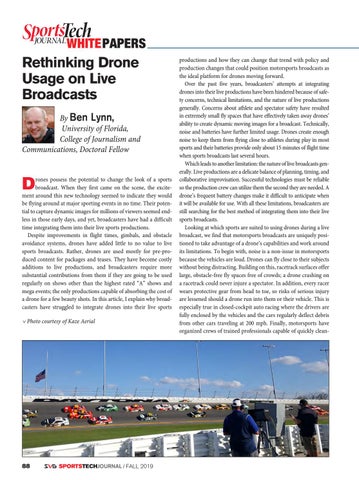WHITEPAPERS
Rethinking Drone Usage on Live Broadcasts By Ben Lynn, University of Florida, College of Journalism and Communications, Doctoral Fellow
D
rones possess the potential to change the look of a sports broadcast. When they first came on the scene, the excitement around this new technology seemed to indicate they would be flying around at major sporting events in no time. Their potential to capture dynamic images for millions of viewers seemed endless in those early days, and yet, broadcasters have had a difficult time integrating them into their live sports productions. Despite improvements in flight times, gimbals, and obstacle avoidance systems, drones have added little to no value to live sports broadcasts. Rather, drones are used mostly for pre-produced content for packages and teases. They have become costly additions to live productions, and broadcasters require more substantial contributions from them if they are going to be used regularly on shows other than the highest rated “A” shows and mega events; the only productions capable of absorbing the cost of a drone for a few beauty shots. In this article, I explain why broadcasters have struggled to integrate drones into their live sports Photo courtesy of Kaze Aerial
88
SPORTSTECHJOURNAL / FALL 2019
productions and how they can change that trend with policy and production changes that could position motorsports broadcasts as the ideal platform for drones moving forward. Over the past five years, broadcasters’ attempts at integrating drones into their live productions have been hindered because of safety concerns, technical limitations, and the nature of live productions generally. Concerns about athlete and spectator safety have resulted in extremely small fly spaces that have effectively taken away drones’ ability to create dynamic moving images for a broadcast. Technically, noise and batteries have further limited usage. Drones create enough noise to keep them from flying close to athletes during play in most sports and their batteries provide only about 15 minutes of flight time when sports broadcasts last several hours. Which leads to another limitation: the nature of live broadcasts generally. Live productions are a delicate balance of planning, timing, and collaborative improvisation. Successful technologies must be reliable so the production crew can utilize them the second they are needed. A drone’s frequent battery changes make it difficult to anticipate when it will be available for use. With all these limitations, broadcasters are still searching for the best method of integrating them into their live sports broadcasts. Looking at which sports are suited to using drones during a live broadcast, we find that motorsports broadcasts are uniquely positioned to take advantage of a drone’s capabilities and work around its limitations. To begin with, noise is a non-issue in motorsports because the vehicles are loud. Drones can fly close to their subjects without being distracting. Building on this, racetrack surfaces offer large, obstacle-free fly spaces free of crowds; a drone crashing on a racetrack could never injure a spectator. In addition, every racer wears protective gear from head to toe, so risks of serious injury are lessened should a drone run into them or their vehicle. This is especially true in closed-cockpit auto racing where the drivers are fully enclosed by the vehicles and the cars regularly deflect debris from other cars traveling at 200 mph. Finally, motorsports have organized crews of trained professionals capable of quickly clean-
